Cloth diapering has evolved tremendously in past generations. When our parents were babies, cloth diapering most likely involved a flat square of fabric or, if our grandparents were fancy, a preflat, worn under a pair of rubber pants. Nowadays, there are loads of different styles of cloth diapers, complete with their own set of mystifying acronyms. My goal in writing this post is to shed some light on the different styles of cloth diapers and decode some of the lingo often used in discussions of modern cloth diapers. More pictures to come soon!
Flat: A flat is simply a single square of fabric, typically made of a woven fabric, such as double gauze cotton muslin or birds eye cotton. Flour sack towels (FST) are also sometimes used as flats. Flats were the original cloth diaper. Measurements vary and are typically anywhere between 28"x28" to 32"x32". Flats are folded in specific ways and either secured on the baby using pins, a snappi, boingo, or diaper belt or laid in a waterproof cover (note: technically water resistant, but the commonly used term is waterproof, so I will continue to use that term throughout the post to avoid creating confusion). Flats must be used in conjunction with a waterproof cover (or changed very often) to prevent leaking. A cloth diapering system of flats and covers is considered to be one of the most economical approaches to cloth diapering.
Stretchy Flat: Stretchy flats are a relatively new take on flats and offer a more secure fit on baby with fewer gaps, especially around the legs. The difference between flats and stretchy flats is only in the material--flats are made from woven (i.e., no stretch) fabric, while stretchy flats are made from knit (i.e., stretchy) fabric. Bamboo (and bamboo blends) seems to be a popular fiber used in stretchy flats, likely due to its softness, stretch, absorbency, and recovery. Stretchy flats are used in exactly the same way as flats--folded and secured around baby or laid in a waterproof cover.

Stretchy Flat made and photographed by Kendal Fikert of PlanetDiaper

Stretchy flat secured with a Snappi diaper fastener made and photographed by Kendal Fikert of PlanetDiaper
Prefold: A prefold diaper was the first "technological advancement" in cloth diapering. Prefolds are square diapers made of several layers of woven fibers, and sewn into three panels with extra absorbency in the middle. Prefolds are typically sized (e.g., newborn - toddler with several sizes in between), and can be trifolded and laid in a waterproof diaper cover, or they can be secured around baby with pins, a snappi, boingo, or diaper belt. If secured around baby, prefolds don't offer the best fit and often gap around the legs due to their bulkiness and the fact that they are made from woven fibers. A cloth diapering system of prefolds and covers is considered to be one of the most economical approaches to cloth diapering.
Preflat: Preflats are newcomers to the cloth diapering world. They arrived fast and furious, and are quickly becoming one of the most popular styles of cloth diapers, especially for cloth diapering overnight. Preflats combine the best elements of stretchy flats and prefolds (hence the name, pre-flat). They are made of stretchy knit fabric, like Bamboo/Cotton French Terry, and typically have additional absorbency (often made of high gsm bamboo fleece, or similar) that is either sewn, snapped, or laid in the stretchy shell. The preflat shell typically has two-three layers that are either sewn or serged together. Preflats have a unique shape that consists of wings on top, and a tri-fold bottom. The "flaps" on the bottom part of the preflat are trifolded toward the middle to maximize absorbency in the middle of the diaper, folded up (toward baby's belly button), and then the wings are folded over, across the waist, and the preflat is secured with either pins, a snappi, boingo, or diaper belt. Preflats vary in absorbency and are typically worn under a waterproof cover. However, they can be worn without a cover during the day, if changed at the first sign of wetness.
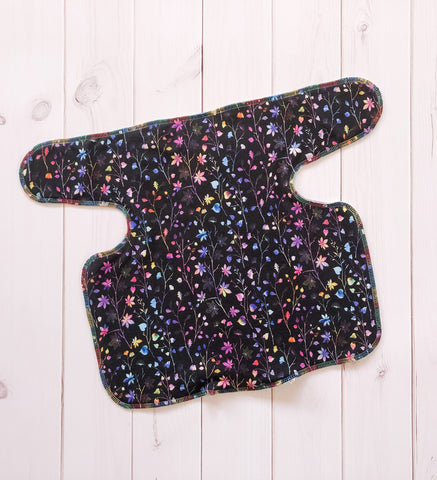
The outside view of a preflat cloth diaper made with PhDetour Bamboo/Cotton French Terry (BCFT). Pattern is The Happy Hippos OS Flawless Preflat Pattern

The inside view of a preflat with a sewn-in doubler and snap-in booster. Absorbent material for doubler and booster is 500gsm bamboo fleece (SHOBF) from Nature's Fabrics.
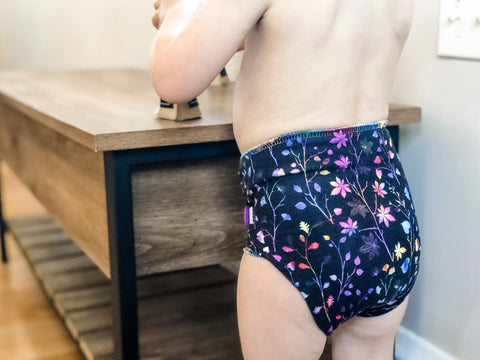
Preflat made with outer layer of PhDetour Bamboo/Cotton French Terry (BCFT) modeled by a child.
Fitted: A fitted diaper is a cloth diaper that looks like a modern cloth diaper, but is made from 100% absorbent materials. It is designed to be worn underneath a waterproof cover. Like preflats, fitted diapers are an excellent option for nighttime cloth diapering, since the whole diaper is absorbent. Fitted diapers typically have elastic in the legs and back, (sometimes) rise snaps to adjust the size, and wing snaps to secure the diaper. Fitted diapers may or may not have additional absorbency that is sewn-in, snapped in, or laid in.
Hybrid Fitted: A hybrid fitted cloth diaper is just like a fitted diaper, described above, but it typically has a middle layer of water resistant polyester fleece (e.g., Windpro) sewn between a knit fabric outer layer and stay-dry inner layer. The addition of this water resistant middle layer typically permits this type of fitted diaper to be worn without a cover.
Cover: A modern cloth diaper cover these days is often made of PUL (polyurethane laminate) which is a water-resistant bonded fabric that is made with a knit printed layer of polyester interlock and laminated with a TPU (thermoplastic polyurethane) film. Diaper covers can also be made of water-resistant materials such as wool or fleece. Covers made with PUL can be made of a single layer of PUL, two layers of PUL, or an outer layer of PUL and an inner layer of AWJ (or similar). If made entirely of PUL (either one or two layers), the inside of the cover will have the shiny (laminate) side of the PUL exposed, which makes the cover wipeable. As long as the cover is not soiled by poop, wipeable covers can be wiped down in between changes and used again before washing. Covers made with an inner layer of AWJ (or similar) are single use, but the benefit is that they are typically softer and are a great option for babies with PUL sensitivity because there is no PUL touching baby's skin. Covers can either be sized (e.g., newborn, small, medium, etc...), or they can be made as one size diaper covers that fit a wide range of weights and sizes and are adjusted with rise snaps. Cloth diaper covers are either secured with snaps or hook/loop closures, and they feature elastic in the legs, back, and sometimes around the tummy.
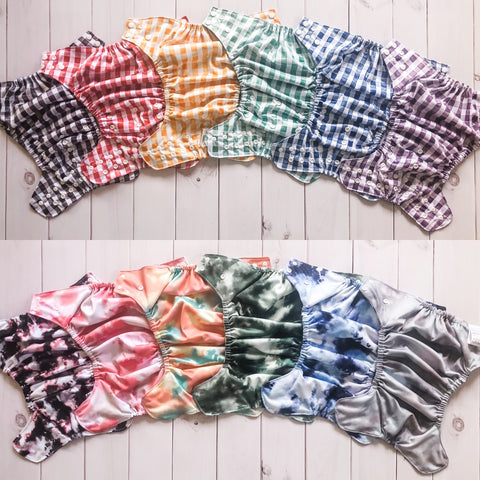
A collection of diaper covers made with PhDetour Luxe PUL (shown in top row) and PhDetour AWJ (shown in bottom row). Pattern is The Happy Hippos OS Flex Cover Pattern
Pocket: A pocket diaper is one of the more popular styles of modern cloth diapers. Pocket diapers feature a PUL outer layer and an inner layer that is typically made from a stay-dry material such as Athletic Wicking Jersey (AWJ), microfleece, or suedecloth. Pocket diapers typically come in "one-size" designs, meaning they fit a wide range of weights. One size pocket diapers are usually made smaller or larger by adjusting the rise snaps on the front of the diaper, and they are secured with either snaps or hook/loop closures. Pocket diapers have elastic in the legs and along the back, and sometimes in the front (known as tummy elastic). There is a pocket opening somewhere in the diaper where a diaper insert, made of all absorbent materials, can be inserted. With this style, the insert does not touch baby's skin. The insert is either removed before washing, or designed to agitate out in the wash. When people talk about "stuffing diapers" they are referring to pocket diapers because the insert needs to be stuffed into the shell before use. Pocket diaper inserts are commonly made of microfiber, which is a synthetic material known for its quick absorbency. Unfortunately, although microfiber inserts are quick to absorb, they are also known for compression leaks when pressure is put on the insert (such as when baby sits down). They are also limited in how much liquid they can hold, and over time their ability to absorb is diminished and they tend to hold on to stinks. A better option (in my opinion) for pocket inserts is a high gsm (grams per square meter, which refers to the weight of the fabric) bamboo fleece, bamboo/cotton fleece, or bamboo/hemp fleece. Inserts made from natural fibers such as these do not typically have the same problems that microfiber inserts do (e.g., compression leaks, retaining stinks, diminishing ability to absorb). It is also important to note that microfiber should never be placed directly against baby's skin.

Example of a Pocket style diaper with leading edge pocket opening made and photographed by Nicole McCormick of McCozy Bottoms. Pattern is the Happy Hippos Flex OS Original Cloth Diaper Pattern
All-in-two (AI2): An AI2 is a style of cloth diaper in which the absorbency is snapped into the diaper shell. The diaper shell is generally made with an outer layer of PUL and an inner layer of either AWJ (athletic wicking jersey), microfleece, suedecloth, or another layer of PUL (or perhaps just a single layer of PUL, similar to a single layer PUL cover) to make it wipeable. AI2 diapers typically come in "one-size" designs, meaning they fit a wide range of weights. One size AI2 diapers are usually made smaller or larger by adjusting the rise snaps on the front of the diaper, and they are secured with either snaps or hook/loop closures. AI2 diapers have elastic in the legs and along the back, and sometimes in the front (known as tummy elastic). AI2 diapers have one or two socket snaps installed in the shell (typically toward the back), where the absorbency is snapped in and out. AI2 inserts are typically made in the same way and with similar materials as Pocket inserts, but they have a stud snap installed on the back of one end so that they can be snapped into the diaper shell. AI2s are a great option for those who hate stuffing diapers, but want to be able to remove the absorbent part of the diaper from the shell.

Outside view of an AI2 diaper made with PhDetour Luxe PUL. Pattern is the Happy Hippos Flex OS Original Cloth Diaper Pattern
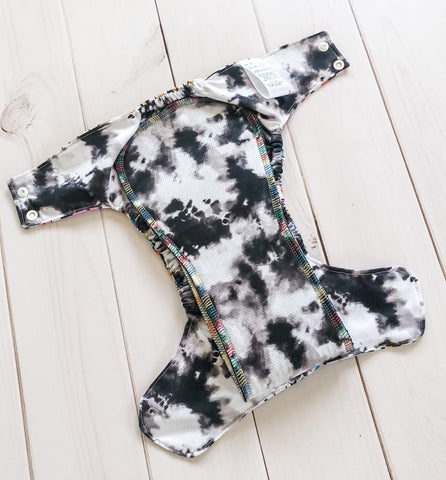
The inside view of an AI2 cloth diaper. AI2 shell is made from an outer layer of PhDetour Luxe PUL, an inner layer of PhDetour AWJ, and the snap-in soaker is made from two layers of 500gsm SHOBF (super heavy organic cotton bamboo fleece) and topped with bamboo velour.
All-in-one (AIO): An AIO is a style of cloth diaper in which the absorbency is sewn directly into the diaper, so you cannot remove the absorbent part of the diaper from the water resistant diaper shell. AIOs are made with an outer layer of PUL, and an inner layer of absorbent material, such as bamboo fleece. Some AIOs have several layers of absorbency sewn directly into the middle of the diaper, while others have snake-style (i.e., an extra long insert able to be folded under itself), or petal-style (i.e., flap) inserts that are sewn into the diaper only on one end. A common complaint with AIO diapers that have all the absorbency sewn directly into the middle of the diaper is that they take forever to dry. Snake style, or petal style inserts in AIOs alleviate this problem. Because the absorbency is sewn in only at one end, the absorbent part of the AIO diaper is free to move around a bit. This style of AIO washes and dries better than AIOs that have all the absorbency sewn in the middle. Like Pocket and AI2 diapers, AIOs have elastic in the legs, back (and sometimes) tummy parts of the diaper, and often come in OS (one size) designs that fit a wide range of weights and are adjusted through rise snaps.
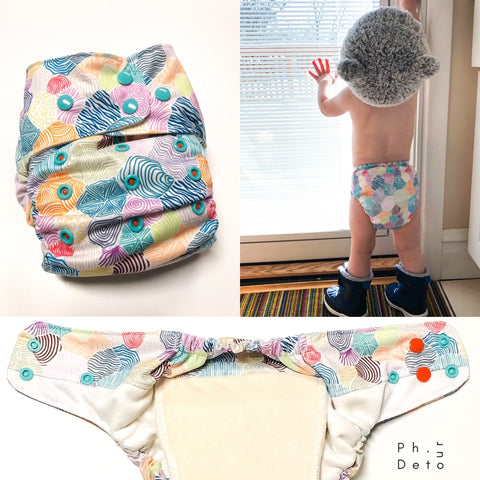
Example of an AIO cloth diaper with a PhDetour Classic PUL outer and AWJ inner, with one layer of SHOBF sewn in under the AWJ, and a snake-style soaker sewn into the back of the diaper. Pattern is the Happy Hippos Flex OS Original Cloth Diaper Pattern
Those are the major styles of cloth diapers that are typically made by those who choose to sew their own diapers. Now, here is a quick guide to other terms and acronyms commonly used in the cloth diaper sewing world, presented in alphabetical order.
AI2: All in two (refers to a style of cloth diaper).
AIO: All in one (refers to a style of cloth diaper).
Aplix: Company that manufactures hook and loop fastening tape. Sometimes company name is used to refer to the hook and loop fastening tape that they manufacture.
AWJ: Athletic wicking jersey (also called Birds Eye Mesh). AWJ is a thin, stay-dry knit fabric made of 100% polyester that has either two-way or four-way stretch. It features dimples (not holes) and is very often used for the inner layer of cloth diaper shells, or as a top layer of cloth diaper inserts. As AWJ is my favorite stay-dry material, PhDetour offers an assortment of high quality digitally printed AWJ that is in stock and ready to ship.
Boingo: Boingo is the brand name for a type of cloth diaper fastener that is sometimes used to secure absorbent cloth diapers that have no snaps. Boingos are made of silicone, so they are designed to stretch a bit (horizontally), and each end features little plastic teeth that are designed to grab the fabric and keep the diaper secured.
Booster: A cloth diaper booster is a stand-alone rectangle of absorbency intended to "boost," or increase the absorbency of your cloth diaper. They are typically made with several layers of fabric, such as bamboo, cotton, or hemp fleece. High quality boosters are typically made with some percentage of hemp due to its ability to hold a higher volume of liquid than other fibers. Although hemp is able to hold a higher volume of liquid, it is slower to absorb said liquid, so it is usually used underneath a faster absorbing material, such as bamboo fleece or cotton fleece.
CD: Cloth diaper.
DISO: Desperately in search of.
Doubler: Doubler is another term for booster (see above).
FST: Flour sack towel.
FTM: First time mom.
GSM: Grams per square meter. GSM refers to the weight (i.e., density) of a particular fabric. Typically when referring to absorbent materials used in cloth diapers, the higher the GSM, the thicker the fabric. Sometimes people also refer to total GSM used in a cloth diaper, which is the sum of the GSM of all the layers of fabric used in a diaper. In general, the higher the total GSM, the more absorbent the diaper will be.
HOBF: Heavy Organic (cotton) Bamboo Fleece. HOBF is typically 400 gsm bamboo (or bamboo blended with cotton or hemp) fleece. It is a very popular fabric used to make diaper inserts/soakers and boosters/doublers. My go-to source for HOBF is Nature's Fabrics
Hook/Loop: Hook and loop tape is a material that is often sewn onto diapers as a closure system. For most covers, pockets, AI2, and AIO diapers, either hook/loop tape is used or snaps are used. Hook and loop tape often goes by the proprietary names of Velcro or Aplix. Hook tape is the scratchy part, and loop tape is the soft part. The hook and loop parts stick to one another. Hook tape is typically sewn onto the wings, and a strip of loop tape is typically sewn on to the front of the diaper for an adjustable closure. Hook tape should be secured with "laundry tabs," which are little squares of loop tape sewn on near the wings, to prevent the hook tape from sticking to, and possibly damaging, other items when being washed.
Insert: A term that is used to refer to the absorbent part of a cloth diaper. Can be used interchangeably with the term "soaker." Sometimes insert is used more frequently when referring to pocket diapers because it is inserted into the pocket part of the diaper, while soaker is used more frequently when referring to AI2 diapers. Both terms simply refer to the absorbent part of a cloth diaper.
ISO: In search of.
LO: Little one.
MF: Microfiber.
NCDR: Not cloth diaper related.
OS: One size.
OTB: On the bum.
PUL: Polyurethane laminate. PUL is the most common waterproof fabric used for the outer layer of many styles of cloth diapers. PUL is a bonded fabric that consists of an outer, often printed, layer made of knit polyester interlock, that is fused to an inner layer of water resistant TPU film. Not all PUL is created equally! The quality and thickness of the TPU laminate varies across manufacturers, as does the adhesive that is used to bond the polyester interlock knit fabric to the TPU film. Some manufacturers use chemical based solvents to adhere the two layers, while others use PUR (polyurethane reactive) hot melt adhesive. And to take this a step further, even among manufactures that use the (much preferred) hot melt adhesive manufacturing process, the quality and type of PUR varies. PUL often varies in thickness and stretchiness across companies. The thickness of PUL varies as a result of the thickness of TPU film used (for cloth diapers, PUL typically ranges from 1mil, which is .001 inches, to 2mil, which is .002 inches), and stretch is typically directly related to the thickness of the PUL. 1mil PUL is generally stretchier than 2mil PUL. However, that is a generalization and not a rule; stretchiness is largely due to the quality of the TPU and the manufacturing process used to create the TPU. All PUL has some two-way, horizontal stretch in varying degrees, and in general, PUL with some stretch is desirable for cloth diapers. 2mil PUL is often preferred by those who make embroidered diapers because it holds up to the embroidery process better than thinner, stretchier PUL. PhDetour originated out of a desire to offer cloth diaper sewists a wide selection of high quality PUL that is 1) in stock, 2) ships fast, and 3) comes in two thicknesses to satisfy a variety of preferences. Our Luxe PUL is laminated with 1mil TPU and is thinner and stretchier, and our Classic PUL is laminated with 2mil TPU and is more structured, less stretchy, and excellent for embroidered cloth diapers and heavier duty items like wet bags, boxy bags, diaper pail liners, totes, etc. Both types of PUL feature crisp, vivid colors, are CPSC compliant, free from harmful substances, and safe for use with food products.
IMPORTANT NOTE: TPU is *not* a stand alone substitute for PUL! Rather, TPU is one component of PUL, not a replacement for it. TPU by itself is a delicate, super thin, transparent film that is worthless in the use of cloth diapers unless bonded to a polyester interlock in the creation of PUL.
SHOBF: Super Heavy Organic (cotton) Bamboo Fleece. SHOBF is typically 500 gsm bamboo (or bamboo blended with cotton or hemp) fleece. It is a very popular fabric used to make diaper inserts/soakers and boosters/doublers. My go-to source for SHOBF is Nature's Fabrics
Snappi: Snappi is the brand name for a type of fastener that is sometimes used to secure absorbent cloth diapers that have no snaps (e.g., flats, stretchy flats, prefolds, and/or preflats). Snappis are made of silicone, intended to stretch a bit, and are designed in a unique T-shape. Each of the three ends of a Snappi features little plastic teeth that are designed to grab onto the fabric and keep the diaper secured.
Soaker: Another term that is used to refer to the absorbent part of a cloth diaper. Can be used interchangeably with the term "insert." Sometimes soaker is used more frequently when referring to AI2 diapers, while insert is used more frequently when referring to pocket diapers. Both terms simply refer to the absorbent part of a cloth diaper.
TPU: Thermoplastic Polyurethane. See explanation above under PUL.
Velcro: A company that makes hook and loop tape. Velcro is the most colloquially well-known brand of hook and loop tape, so much so that hook and loop tape is often referred to as Velcro.
WAHM: Work at home mom. People who identify as moms and run their own businesses making and selling cloth diapers that they make themselves in their homes. In general, I have found the quality of WAHM-made cloth diapers to be far superior to commercially produced diapers.

